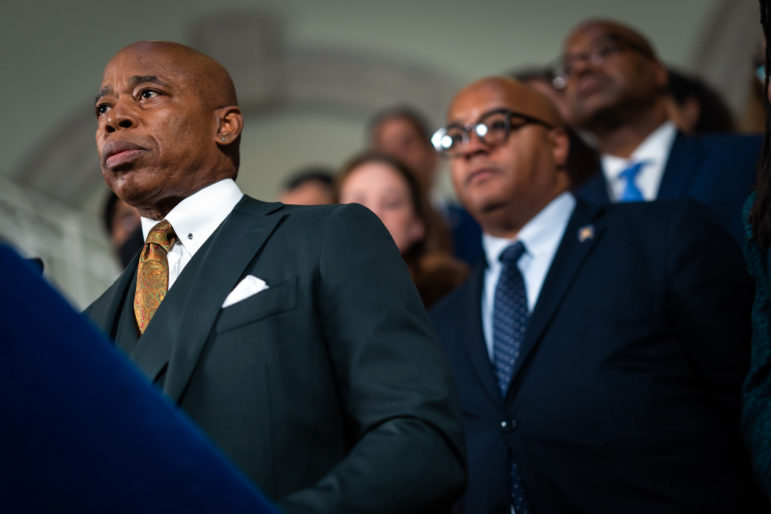“This policy, while likely formed with good intent, is short-sighted and places more strain on a system that is close to breaking. It also shifts focus and continues to villainize individuals who need help, rather than providing the resources that they desperately need. This is a band-aid, meant to make the problem less visible, ignoring the real issues.”

Ed Reed/Mayoral Photography Office.
Mayor Eric Adams announcing the new directive at a press conference in November.The New York City Bar Association is advocating for the pause of Mayor Adams’ recent policy that will involuntarily hospitalize New Yorkers for mental illness, potentially impacting thousands of people.
This policy, while likely formed with good intent, is short-sighted and places more strain on a system that is close to breaking. It also shifts focus and continues to villainize individuals who need help, rather than providing the resources that they desperately need. This is a band-aid, meant to make the problem less visible, ignoring the real issues.
Where will these people go? Involuntary hospitalization only works if there are enough resources and beds for patients. Psychiatric beds were decreasing even before COVID-19 and New York State has 16.3 beds for 100,000 people. Most experts and institutions consider 30 beds for 100,000 people as the minimum acceptable standard. With this shortage, involuntarily hospitalized individuals will stay in emergency rooms and in medical wards.
It’s not uncommon to wait multiple days and even weeks for a psychiatric bed opening. This contributes to bed shortages, leading to increased wait times for other hospital procedures and stays. And without necessary resources besides inpatient psychiatric beds, such as appropriate housing, healthcare, food vouchers, and transportation, many individuals end up back on the street.
Another problem is how this process will be implemented. Daniel Prude was a Black man who died in police custody in Rochester, NY, during March of 2020. Mr. Prude, who was likely suffering from an acute psychotic episode, was restrained by police, who placed a hood over his head, and then held him down against the pavement for two minutes. He later died, with the medical examiner citing “excited delirium,” a racist and pseudoscientific diagnosis used to justify police brutality. This new policy may lead to hundreds more of these confrontations and we do not have the resources nor training to effectively practice de-escalation. This will place police officers, medical professionals, and unhoused individuals into dangerous situations.
There are other evidence-based and effective resources. Housing insecurity and mental health are closely connected. Instead of trying to institutionalize individuals in overcrowded hospitals, the city should be investing in longer term solutions to increase affordable housing. Ongoing and impactful national and local programs already exist to serve as models for future implementation.
Long-term strategies also need flexibility and continued input, as evidenced by the results of permanent supportive housing. These programs have shown that additional support, such as employment and robust mental health resources, are needed to make these programs work.
Yes, this will cost money, but it is also expensive to involuntarily hospitalize people. Involuntary hospitalization is another program that takes advantage of a misaligned safety net, which costs significant amounts of money. Many unhoused individuals lack insurance and their healthcare bills from these hospitalizations will be covered either by write-offs or through the disproportionate share hospital program (New Yorkers’ tax dollars). This is not inconsequential; frequent fliers to the emergency room often accumulate bills in excess of $50,000 annually.
The days and weeks spent waiting for an inpatient psychiatric bed will only waste money. Instead, these funds should be invested in housing and behavioral health infrastructure, interventions that have positive returns. Investment in mental health resources and treatment is money well spent; for every $1 spent there is an average return of $4 from increased productivity and health.
We need to be patient and work on sustainable solutions. Involuntary hospitalization is not one of those solutions, at least not in the current system that lacks resources and social safety net to adequately care for each person. If Mayor Adams is serious about addressing both the housing and mental health crisis, he needs to invest in long term solutions, not just window dressing that hides the problem.
Joshua Budhu is a Neuro-Oncologist and Health Equity Researcher at Memorial Sloan Kettering Cancer Center and a Public Voices fellow of TheOpEdProject and AcademyHealth.









2 thoughts on “Opinion: Forced Hospitalization is the Wrong Approach to Mental Health”
I am waiting the result of this project.
Solid arguments and I would share this piece, except for the use of the offensive and dehumanizing term “frequent fliers.” Please stop using this language immediately. They are people in distress who need help and are not getting it so they keep returning. This dehumanizing language undermines the author’s arguments.